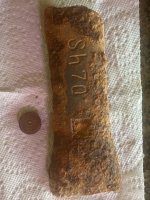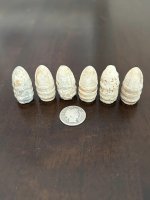Badger Bart
Sr. Member
- Mar 24, 2005
- 301
- 18
"Lost Colony?" Oldest Cannon Survey For Shipwreck Progresses
Researchers return with clues to ship from late 1500s
By JACK DORSEY, The Virginian-Pilot
© July 17, 2006
NORFOLK - Archaeologists, looking for the sailing ship that carried the oldest English cannon ever found in the United States, have returned from offshore waters with new surveys of the ocean floor that they hope will help locate the 400-year-old vessel.
"There's no eureka moment yet," said Rod Mather, a maritime history professor at the University of Rhode Island who led the recent survey.
"But we've got a lot of possibilities," he said, referring to about 200 "targets," or areas of interest, found in a five-by-five-mile box on the ocean bottom.
What led Mather, two graduate students - James Moore and Alicia Caporaso from the graduate School of Oceanography at URI - and technicians aboard the National Oceanic & Atmospheric Administration's survey ship Thomas Jefferson to the area was a barnacle-encrusted cannon hauled up in a fishing trawler's net in 1980 off the Virginia-North Carolina coasts.
The gun, found fully loaded, its black power packed so tightly it remained dry, was ready to fire a 2 1/2-inch iron ball and a dozen grape shot, also found inside, according to news accounts at the time.
Restored at East Carolina University, it is on loan to the Roanoke Island Festival Park's Adventure Museum in Manteo, N.C.
If hydrographic and magnetometer sketches that Mather and his party returned with from their 10-day effort last month can confirm the existence of the 16th-century ship that carried the cannon, the find may help solve long-held mysteries.
Or, it's also possible no answers will come, said the veteran archaeologist, a specialist in the Anglo-Atlantic world, with a reputation in the maritime community as being among the best at finding and interpreting ancient wrecks.
"It's possible it could be associated with the Lost Colony," Mather said, referring to the Roanoke Island, N.C., settlement founded by English colonists who disappeared without a trace between 1587 and 1590.
The cannon could have been aboard their ship, which was attempting to return the disillusioned colonists to England, when it sank in a storm. "It's possible it's associated with early Virginia, " he added. "It's possible it is associated with (Sir Francis) Drake's fleet that was damaged by a hurricane in 1586-87.
"It's possible that the cannon is an isolated find that was lost overboard by a vessel passing by."
In a big ocean, the chances for success are not good, Mather conceded.
"But they are about as good as we could hope for, especially because of who we have involved," he said, referring to the NOAA ship Thomas Jefferson and its crew, based in Norfolk.
Side scanning sonar, which gives images of the ocean's floor in color and in three dimensions, has improved greatly over the years, as have other techniques, Mather said.
"Plus, the folks on the Jefferson are about as good as anybody there is. That's why we are particularly excited about working with them."
Mather, who was interviewed by phone, said his expedition traced over the 25-square-mile section of the ocean floor twice.
Because of concern that treasurer hunters could loot the site, the exact location of the surveys will not be disclosed, said Fred Gorell, a NOAA spokesman.
"This is a remote sensing phase that probably is not going to identify any particular ship, but it may find some targets that potentially, further down the line, could result in something more definitive," Gorell said.
"So we are really at the very early exploratory phase."
The trip was made possible by a $58,000 grant from NOAA's Office of Ocean Exploration.
Until he studies the images more closely, Mather said, he is reluctant to release the sonar images.
Mather was a graduate student in the mid-1980s when he first studied the 4-1/2 -foot long, 300-pound cannon after it was restored.
Called a "field piece," or English falcon, it was used for self-defense and was of the type that would have been used by the colonists settling in the New World, according to a story in The Virginian-Pilot on Nov. 19, 1989.
Now that Mather and his graduate students have returned from their expedition, they plan to spend months studying what the sonar and other electronics found.
Mather brought a magnetometer on the survey; it detects distortions in the Earth's magnetic field. It also will detect geological features, including those created by ferrous objects, he said.
For example, if the magnetometer was towed close enough, it could detect an iron cannon, even the iron fastenings of a shipwreck.
Of the 200 targets found, they identified 50 that had the most promise of being ship remains and "we narrowed that down to about 20 that we think are our best shot," Mather said.
The magnetometer was towed above some of those and about three sites indicated there was ferrous metal in them, he said.
"We did, in addition, find three shipwreck sites, but they were definitely not what we were looking for because they are much more modern, much larger and recognizable as shipwrecks."
The remains of a ship from the Colonial era would bear little resemblance to a more contemporary ship, leaving at most piles of rock that were used for ballast, perhaps another cannon, or some metal.
Several months of studying the sonar images lie ahead, Mather said.
"We don't know for certain what any of them are and we won't know until, or unless, we send robots down, or send divers down," he said.
"The problem with these types of things is they often take a long, long time. We are only 20 years into it, so it will likely take us some time to get through the data and make a decision about what we would like to try and do next.
"We've got to work our way through all this data, and it is a matter of several months to crunch our way."
http://home.hamptonroads.com/stories/story.cfm?story=107675&ran=104177
Researchers return with clues to ship from late 1500s
By JACK DORSEY, The Virginian-Pilot
© July 17, 2006
NORFOLK - Archaeologists, looking for the sailing ship that carried the oldest English cannon ever found in the United States, have returned from offshore waters with new surveys of the ocean floor that they hope will help locate the 400-year-old vessel.
"There's no eureka moment yet," said Rod Mather, a maritime history professor at the University of Rhode Island who led the recent survey.
"But we've got a lot of possibilities," he said, referring to about 200 "targets," or areas of interest, found in a five-by-five-mile box on the ocean bottom.
What led Mather, two graduate students - James Moore and Alicia Caporaso from the graduate School of Oceanography at URI - and technicians aboard the National Oceanic & Atmospheric Administration's survey ship Thomas Jefferson to the area was a barnacle-encrusted cannon hauled up in a fishing trawler's net in 1980 off the Virginia-North Carolina coasts.
The gun, found fully loaded, its black power packed so tightly it remained dry, was ready to fire a 2 1/2-inch iron ball and a dozen grape shot, also found inside, according to news accounts at the time.
Restored at East Carolina University, it is on loan to the Roanoke Island Festival Park's Adventure Museum in Manteo, N.C.
If hydrographic and magnetometer sketches that Mather and his party returned with from their 10-day effort last month can confirm the existence of the 16th-century ship that carried the cannon, the find may help solve long-held mysteries.
Or, it's also possible no answers will come, said the veteran archaeologist, a specialist in the Anglo-Atlantic world, with a reputation in the maritime community as being among the best at finding and interpreting ancient wrecks.
"It's possible it could be associated with the Lost Colony," Mather said, referring to the Roanoke Island, N.C., settlement founded by English colonists who disappeared without a trace between 1587 and 1590.
The cannon could have been aboard their ship, which was attempting to return the disillusioned colonists to England, when it sank in a storm. "It's possible it's associated with early Virginia, " he added. "It's possible it is associated with (Sir Francis) Drake's fleet that was damaged by a hurricane in 1586-87.
"It's possible that the cannon is an isolated find that was lost overboard by a vessel passing by."
In a big ocean, the chances for success are not good, Mather conceded.
"But they are about as good as we could hope for, especially because of who we have involved," he said, referring to the NOAA ship Thomas Jefferson and its crew, based in Norfolk.
Side scanning sonar, which gives images of the ocean's floor in color and in three dimensions, has improved greatly over the years, as have other techniques, Mather said.
"Plus, the folks on the Jefferson are about as good as anybody there is. That's why we are particularly excited about working with them."
Mather, who was interviewed by phone, said his expedition traced over the 25-square-mile section of the ocean floor twice.
Because of concern that treasurer hunters could loot the site, the exact location of the surveys will not be disclosed, said Fred Gorell, a NOAA spokesman.
"This is a remote sensing phase that probably is not going to identify any particular ship, but it may find some targets that potentially, further down the line, could result in something more definitive," Gorell said.
"So we are really at the very early exploratory phase."
The trip was made possible by a $58,000 grant from NOAA's Office of Ocean Exploration.
Until he studies the images more closely, Mather said, he is reluctant to release the sonar images.
Mather was a graduate student in the mid-1980s when he first studied the 4-1/2 -foot long, 300-pound cannon after it was restored.
Called a "field piece," or English falcon, it was used for self-defense and was of the type that would have been used by the colonists settling in the New World, according to a story in The Virginian-Pilot on Nov. 19, 1989.
Now that Mather and his graduate students have returned from their expedition, they plan to spend months studying what the sonar and other electronics found.
Mather brought a magnetometer on the survey; it detects distortions in the Earth's magnetic field. It also will detect geological features, including those created by ferrous objects, he said.
For example, if the magnetometer was towed close enough, it could detect an iron cannon, even the iron fastenings of a shipwreck.
Of the 200 targets found, they identified 50 that had the most promise of being ship remains and "we narrowed that down to about 20 that we think are our best shot," Mather said.
The magnetometer was towed above some of those and about three sites indicated there was ferrous metal in them, he said.
"We did, in addition, find three shipwreck sites, but they were definitely not what we were looking for because they are much more modern, much larger and recognizable as shipwrecks."
The remains of a ship from the Colonial era would bear little resemblance to a more contemporary ship, leaving at most piles of rock that were used for ballast, perhaps another cannon, or some metal.
Several months of studying the sonar images lie ahead, Mather said.
"We don't know for certain what any of them are and we won't know until, or unless, we send robots down, or send divers down," he said.
"The problem with these types of things is they often take a long, long time. We are only 20 years into it, so it will likely take us some time to get through the data and make a decision about what we would like to try and do next.
"We've got to work our way through all this data, and it is a matter of several months to crunch our way."
http://home.hamptonroads.com/stories/story.cfm?story=107675&ran=104177





